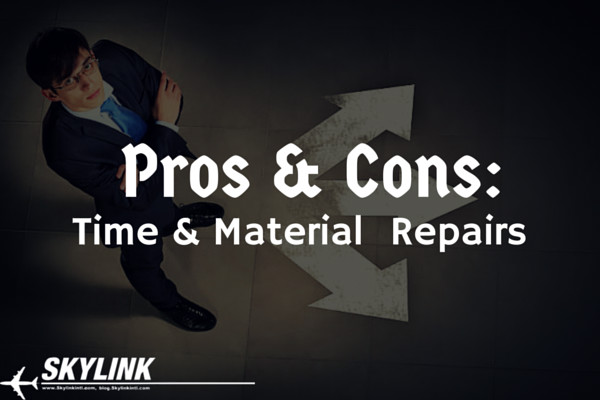Imagine seeing this headline: “Major Airline Uses Student Pilots on Passenger Flights.”
Why Aircraft Maintenance Regulations Are Annoying & How We Overcome It
Aircraft maintenance regulations are annoying. People, even you, complain about regulations. Like you just received a burger without the bun. You despise. it. It annoys you. You feel it slows your workflow. And don't get me started on all the unnecessary paperwork.
New ADs: CRJ Correct Damaged Blowout Panels & G650 Correct Inadequate Torque
 Here's this weeks ADs to help you take the right measures to fix and correct the reported problems.
Here's this weeks ADs to help you take the right measures to fix and correct the reported problems.
If you already have expertise on this issue, please make your comments in the comment section below. Let's keep the conversations going so we continue to keep reliable aircraft in the air.
[Tweet "Let's keep the conversations going so we continue to keep reliable aircraft in the air. ;)"]
CRJ 100, 400, 700, & 900 AD to detect and correct damaged and detached WLPAs and BOPs
"This AD requires repetitive detailed inspections of the cage assembly, window louver panel assemblies (WLPAs), and blowout panels (BOPs), and corrective action if necessary. This AD was prompted by reports of several cases of damaged or detached decompression WLPAs and BOPs. We are issuing this AD to detect and correct damaged and detached WLPAs and BOPs. A detached WLPA or BOP could delay smoke detection in the cargo compartment, and in the event of a cargo compartment fire, this could lead to an uncontrolled cargo compartment fire."
G650 aircraft AD to detect and correct inadequate torque on the self-sealing coupling
"We are adopting a new airworthiness directive (AD) for certain Gulfstream Aerospace Corporation Model GVI airplanes. This AD requires repetitive breakaway torque checks and torquing of the brake inlet self-sealing couplings. This AD also requires revising the airplane flight manual to include procedures to follow in the event of certain display indications. This AD was prompted by reports of the self-sealing couplings on the brake inlet fitting that have been found backed out of the fully seated position. We are issuing this AD to detect and correct inadequate torque on the self-sealing coupling. This condition could result in an unannounced total loss of braking capability on one or multiple brakes, which could result in a runway overrun or asymmetrical braking that can lead to a lateral runway excursion."
Cost = $170 per check/torque cycle
Gear Collapses & Wing Structural Failure
Never Forget Your: Aircraft Maintenance
Detect and correct missing fuselage frame straps and frame cracking for B737 operators — "We are issuing this AD to detect and correct missing fuselage frame straps and frame cracking that can result in severed frames which, with multiple adjacent severed frames, or the combination of a severed frame and fuselage skin chemical mill cracks, can result in uncontrolled decompression of the airplane. An estimated cost of $1,785 per inspection cycle."
C130 structural failure of the wings — "This AD was prompted by an evaluation by the designapproval holder (DAH) that indicated that the CWB is subject to widespread fatigue damage (WFD). We are issuing this AD to detect and correct fatigue cracking of the lower surface of the CWB, which could result in structural failure of the wings. Estimated cost is $170,000 per inspection cycle."
Mexican 737-300 suffers gear collapse after touchdown — "Mexico City’s international airport was forced to close a runway for 4h after a Boeing 737-300 suffered a landing-gear collapse after touchdown. The accident involved a Magnicharters service, UJ779, from Cancun."
[Tweet "Air safety and the public interest require adopting this AD.."]
Never Forget Your: Components
Emirates Tears Out In-Flight Entertainment Screens in Favor of Larger Ones — "Emirates airlines has made some strong brand positioning decisions recently, including the switch to a two-class cabin A380 which eliminates the First cabin and brings the passenger numbers in Economy to a record 615 on flights to Copenhagen."
Zodiac’s Seat Woes Continue to Weigh on Results — "Presenting its worst ever financial results on November 25 in Paris, French supplier Zodiac Aerospace said it continues to suffer from its well-publicized airliner seat crisis. By November 24 its backlog of delayed seat deliveries stood at 500 “packs,” or the equivalent of 1,500 economy seats."
[Tweet "This week in aviation #news #roundup"]
Never Forget Your: Experts
The Lessons Learned From A Failed Aircraft Maintenance Check Plan — "Have you ever tried juggling multiple things at once? You secretly whisper yes while you think of the dreadful memories. The good news is you’re not alone."
[Tweet "Problems always pop up so getting started quickly is key. #aircraftmaintenance"]
Never Forget Your: Tips, tricks and trends
Airbus has a crazy idea to speed up airplane boarding that looks like something from 'Thunderbirds' — "Unless you're deathly afraid of planes, one of the worst things about flying is the sheer tedium of it. It's nothing but indeterminate waiting — waiting for security, waiting to board, waiting to reach your destination."
Air traffic relations key to Middle East growth, Iata chief says — Countries in the Middle East must expand cooperation on air traffic management and improve safety and security standards to take advantage of surging passenger demand, as the region is expected to lead aviation growth, the International Air Transport Association chief said.
[Tweet "#Aviation tips, tricks and trends"]
Why AOGs Drive Airlines Crazy & How to Minimize Their Impact
Great News! You can find this blog post featured on MRO Network. Markets are competitive. Finding the right economical balance between costs of Aircraft on Ground (AOG) and stock is critical.
It’s these decisions that give you, the operator, a competitive advantage. AOGs are a thorn in your spine. They give you an overwhelmed feeling deep in the pit of your stomach. A feeling you can't outrun. This is why planning and knowing your operational downside is important.
Not all AOGs are created equal
Most carriers make the mistake of believing AOGs are costly. They use the term "cost" loosely. When there’s no pre-defined measure of what cost really is, airlines start making wrong decisions. When you're first battling your AOG problem, it’s important to know what your AOGs costs are. You won't be completely accurate buts it's creating a baseline that's important part.
AOG costs vary from airline to airline. They can cancel flights or delay them for hours. Passenger carriers don't lose revenue since passengers are re-booked. But customer moral sinks. Any delay, passengers get upset. Knowing a customer's lifetime value is smart business as it'll tell you what a lost customer costs. Early morning AOGs will screw up the entire day's schedule while late domestic flights will not.
Other scenarios are at play as well. Load factors, passenger mix and aircraft type all play their part.
If you’re a cargo carrier, you can’t simply rebook passengers. You may lose all revenue if the cargo isn’t delivered on time. This is why you have more support aircraft.
And if that wasn’t enough, you'll need to know the cost of other variables:
• Meals
• Accommodations
• Transportation
• Additional crew costs
• Mechanics overtime
• Component shipping costs
• Productivity losses
Then there comes the AOGs costs that affect the rest of the schedule. If this AOG occurs, what other costs will you experience throughout the network? Putting a figure on this is important.
Actionable tip: Know your AOG cost. A fair estimate is better than no estimate at all.
Create a parts stock model
You’ll then need to figure out how likely each AOG will occur.
Start with your reliability of no-go parts. These are the category 1 on the minimum equipment list (MEL). When these parts malfunction or go bad you’ll have an AOG to deal with.
The next thing you’ll need to do is translate the AOG costs you calculated into a required level of parts stock. In the past this was done through a Required Spare Provisioning List (RSPL) model. This is easier said than done. RSPLs vary in how complete they are and their overall sophistication. Some airlines will use these for initial stock provisioning while other airlines just don't have the time.
The RSPL model will help determine the aircraft part demands by airport and consider transport times.
There’s a ton of software that can help achieve this, if you have the budget and time for implementation.
Actionable tip: Compile a list of your no-go aircraft parts. If you lack the time and budget, work with your preferred spares partner to be ready for AOG situations. Create a transit time from their facility to all your airports. Be prepared. Then, once you have the time and budget, refine this process and make it more integrative.
Arrange your buy, lease or pools
Your next AOG battle is to decide how much capital you want to tie up on the shelves.
Some airlines and MROs prefer to keep their stock in house. They feel as though they’re more in control over their stock. If you go this route, just know the opportunity costs of the money that’s being utilized for this specific strategy. More airlines are putting more trust in aggregators, as that’s what they do.
You must decide if it's more beneficial to take care of it yourself, or outsource so you can focus attention to other areas.
Each is a viable option.
Actionable tip: Work with an aircraft spares partner. Talk with them about the exact problems you’re looking to overcome and let them come up with solutions on how to solve it. Notice if they talk about themselves, they’ll care more about their bottom line than yours. You’ll also want a partner who can support you on the expendables and repairs front as well. This will save you hundreds of hours every year with a tight focus on your entire spare needs.
Understand that once you have a model in place it won’t solve your entire problem. You’ll never know entirely what a real AOG will cost. There’s just too many variables. But having realistic estimates will save you a ton of time and money.
Understand your tradeoffs between AOGs and inventory costs and start making incremental changes.
Why Your Urgent RFQs Become AOG & How to Fix It
You’re always stuck firefighting AOGs. It’s routine for you. A normal way of your aviation life. Yet, every time it wastes time and money. It’s a burden. It’s stressful. It’s wasteful.
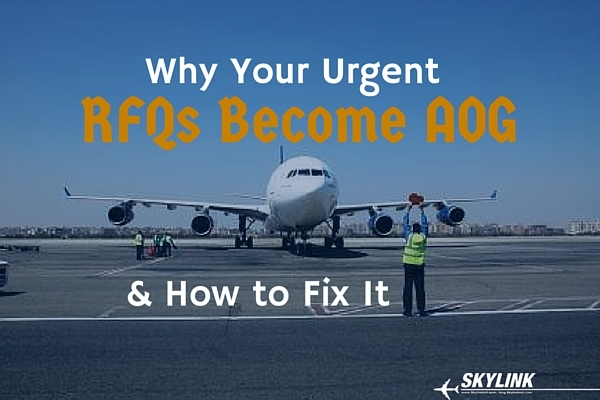
100% of the airlines and MROs we work with struggle with the same problem. Some more than others.
When AOGs happen, you’re in trouble. You do everything you can to resolve the issue. It drains your time, you spend extra money and you have better things to do.
What if you could reduce your AOGs?
You were urgent and now you’re AOG. Why?
Follow me through this narrative….
It’s Monday, an airline (you) asks Skylink for 5 urgent aircraft components. 3 days later we check in with you to make sure everything is going good since you haven’t asked us to ship. On the 7 day you call us saying you're now AOG. In 2 days, your aircraft will be grounded, so you need these items rushed.
You go from an urgent request to an AOG request.
You go from nominal processing and shipping costs to doubling your expenses. We’ve seen expenses go as high as 13x the original direct cost due to AOG shipping costs and fees.
Crazy!
You had everything planned with your original request. You asked for a quote and you got the quote. The items were ready, waiting for you to make a decision. But you decided to wait.
It’s natural. You want to wait as the urgent request may resolve itself. Yet decisions like this cost the industry millions of dollars a year.
The most urgent items will not become less urgent over time. They progress into an AOG. Causing you time and money.
Rarely you’ll solve the urgent request by yourself with internal means.
Statistically, you’re taking a gamble. A big gamble.
How can you stay in the urgent and avoid the AOG?
Every day we think about ways to help you resolve AOGs. We’re pretty darn good at it too. But that’s not enough.
Being fast to get you what you want, when you want it still costs you more time and money then you deserve.
Here’s something we’re playing with…
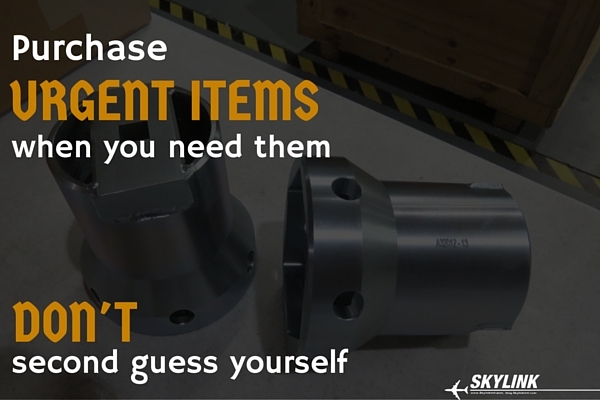
You need to purchase the urgent items when you need them. Don’t second guess yourself. Worst case scenario you resolve the issue and have an extra order on your hands. The best case scenario, you have support components to resolve an urgent situation before it costs you AOG fees.
You can calculate your return on investment by making a smart, quick and decisive decision. But, this still adds a small burden to you.
What if you could then return these items if you figure things out? These urgent items will act as an insurance policy to avoid an AOG and you have the peace of mind for a simple return.
Would a peace of mind guarantee make your life easier? Would it help you purchase urgent items and resolve a request before it becomes AOG with the peace of mind of being able to return them with little hassle?
We would love to hear your thoughts on how this idea would help your operation.
Email your dedicated Account Manager or our VP Nate Anglin (nate@skylinkintl.com) and discuss the benefits this would create for you and how we can implement it to best serve you.
Pros & Cons: Time and Material Aircraft Part Repairs
You have a pile of repair orders on your desk. They sit, waiting for you to take action. Do you approve or deny them? It’s a constant price and lead time battle.
With your aged fleet, time and material aircraft part repairs is the best strategy for you. It gives you more flexibility. It’s the shirt that fits nice. It’s not too tight where it's choking you or too loose making you look sloppy.
When you adopt a time and material repair strategy, here’s some of the pros and cons to look out for.
[Tweet "The pros and cons to look out for when you adopt a time and material repair strategy"]
Let’ start with the cons…
Cons for an aircraft part time and material repair strategy
As with any decision, you must always consider your downside, or simply put, the cons.
Here’s some of the cons:
• Unpredictable repair prices. MROs will give you an average but the price swings can be great.
• Unpredictable lead times. Nothing is a guarantee.
• Varied customer experience.
• Varied piece part quality.
• Varied piece part pricing. Some MROs inflate piece parts or charge your NE pricing for NS or serviceable.
• You’ll spend more time managing your repair orders.
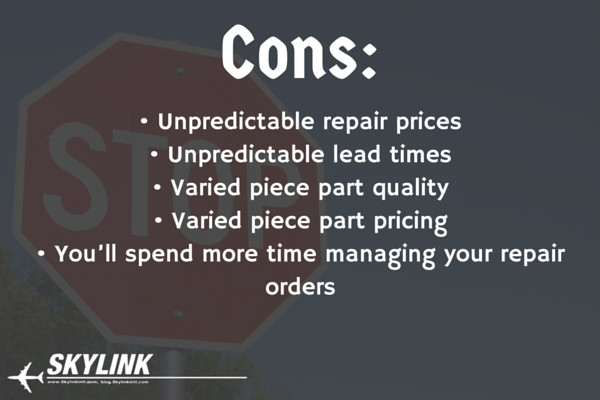
Pros for an aircraft part time and material repair strategy
Just because there’s a few cons doesn’t mean you should avoid them entirely. Time and material repairs can have a great upside, depending on your product or ATA chapter.
Let’s run down a few of the pros:
• You can control the cost by supplying your own piece parts.
• You have more control over your repair orders.
• You can fire your MRO for being too slow or having poor quality.
• The labor rates are either fixed or variable based on hours worked.
• You can avoid MRO bottlenecks by using different tiers of preferred MROs.
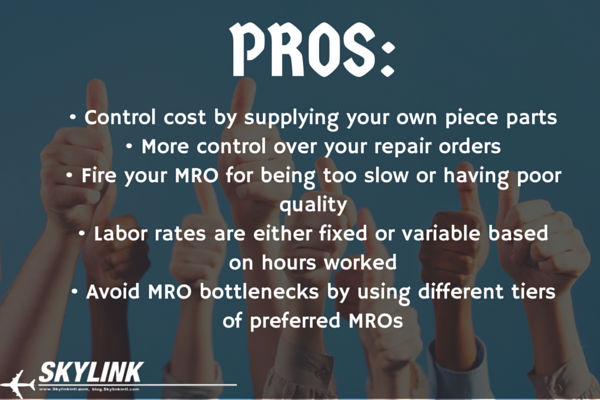
Whatever you choose, whether it be fixed rate or time and material, there’s pros and cons of each.
When deciding your repair strategy, sit down and write down your goals. What’s the end result you want to achieve?
If you want more freedom, outsource. If you want more cost predictability, fixed rate. If you want more control, time and material.
5 Reasons Why Purchasing Standards Will Change Your Life
Did you know you’re urgent day-to-day routine effects your purchases? Your urgency helps tasks but leaves you rushing and lowering your purchasing criteria. Often price is your main objective. As long as you have the cheapest price you’re happy. Right?
Being “cheap” cost you more than you think. Rushing your buying process and only shopping for the best price you’re missing out on quality and value. Rushing when purchasing makes you an emotional buyer and that can cost you tons of money in this game.
Create yourself purchasing standards.
Here are 5 reasons why purchasing standards will change your life.
Keeps You on Target
When you purchase on emotion, you purchase with what you “think” is the best decision. Hormones play with your mind.
Emotions will overrule your best long-term decision.
Creating a purchasing standard, you’ll commit yourself to overall excellence. You’ll avoid making fast, emotional decisions that lead you to heartache and pain.
Helps Avoid Scammers
I’ve said it before and I’ll say it again, aircraft component scammers are active and ready to take your time and money. It’s a fact of life.
One of the best ways to avoid scammers is with a purchasing standard. When you set standards you create a blueprint for excellence. You create an ideal world. A preferred supplier persona.
[Tweet "When you set standards you create a blueprint for excellence"]
More Focused on Total Cost of Ownership
Direct cost and lead time is how you make your decisions. Both of these are incredibly important but so is the total cost of ownership. Once you set your purchasing standards, you’ll have a guide that helps you make the best overall decision. Direct costs are often used as a vanity metric. Total cost of ownership is your primary metric for purchasing excellence.
Reduce Processing Costs
Processing costs are a part of the total cost of ownership but they play a critical role here.
Orders being processed are often followed by a huge productivity slump. After an RFQ (request for quote) is created, competing quotes are received, the order is placed and issues resolved. Productive time is literally flushed down the toilet.
Once you have your purchasing standards created, you’ll reduce time and money processing orders. You’ll have a fluid process to go to every time.
Better Decisions
As orders are being placed, you’ll make better decisions on what components to purchase. You’ll be faster at solving problems as they pop up.
You live in aviation. Issues happen but solving them fast and with least financial impact is critical. Your purchasing standards will help guide you through this process. It’ll tell you how to handle such problems.
I find that most problems are unique as a standalone issue, but they all follow the same decisions making process.
Creating purchasing standards for your aircraft components will help save you time and money over the life of your purchases. It’s their guide to you, to be your point of reference in times of difficulty.
First start by working with a partner who embodies everything you would want in an ideal vendor. They reply to you fast, they have what you want, when you want it. They accept problems and solve them not leaving you to figure it out all alone. That’s an ideal vendor. A true partner.
Once you have that, start by creating your purchasing standards on the ideals they represent. Simple!
10 Ways to Avoid Aircraft Component Scammers
We’ve all been there. You purchase an aircraft component and never receive it. You've been scammed. Or you receive something that’s vastly different than what you ordered.
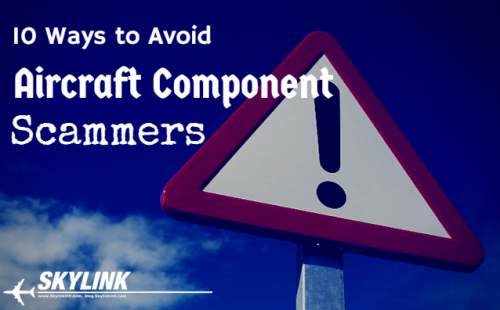
In either case you've been duped, tricked, and fooled into paying for something that was a lie.
Money is thrown in the garbage and you’re left having to fix it.
You think you’re alone when this happens. Sadly, you're not alone.
A few years ago we bought an INU for $15,000. The "company" was based out Atlanta. GA.
Before paying we revised the airworthiness certa. Everything checked out. The vendor sent us an AWB.
The next day, nothing showed up and nothing tracked. We called the local FedEx branch and they said they have a guy on video coming back to pick up the part.
We were officially scammed.
Thankfully for me I have a cousin in the FBI and a few friends gave these scammers a nice phone call. Over the next couple weeks we had our check back.
We can't all be so lucky every time.
We’ve also encountered a $30,000 fraudulent wheel assembly purchase out of Turkey. We avoided it using the tips below.
Smell the scammer
[Tweet "If it looks like a scammer and it smells like a scammer then it is a scammer. #avgeek"]
During your first communications you’ll have clear signs of what type of person you’re dealing with. He probably even smells funny through the phone. If you smell a stench, hit the trench.
Reliable partners are completely transparent. You can find them online, they’ll video chat with you and they’ll reply to you during all hours of the day.
Scammers want to keep a low profile and they ALWAYS use aliases. It’s your responsibility to connect the dots. If the dots are easier to connect, you have a legit company.
Disclaimer: just because they’re legit doesn’t make them good. Legit companies can still be horrible to work with.
Ways to avoid being tricked
We’ve been tricked into buying fraudulent aircraft parts numerous times. It's tough to spot especially if you're in a rush.
We’ve also received parts that weren’t what we ordered and getting it resolved was a pain.
Here is a list to help you avoid be scammed. If you’re dealing with someone that resembles these be cautious.
- They don’t have a professional website.
- They have a standard email address like @gmail or @hotmail.
- They don’t give you their phone number, better yet they hide their mobile #.
- They write emails unprofessionally.
- You request documents and it takes then a couple days to get them to you.
- You request a picture of the unit but all you get is one picture fuzzy looking thing.
- You request a picture of the id plate and the S/N doesn’t match their paperwork.
- You ask if they take credit card and all they take is wire transfer.
- You ask them to fill out your QA audit form and they don’t have an internal QA policy and they can’t send you a copy of their QA manual.
- You can’t find the person you’re purchasing from on the internet.
These are the best ways to spot a scammer. Professional aircraft component scammers have to keep running. They lurk in the shadows.
When talking with them something will always be suspicious. Keep ears and eyes open.
Better yet, if they resemble some of these points above, run away.
Calculate Aircraft Rotable Lifecycle Costs in 7 Easy Steps
Every time you buy an aircraft rotable, how much does it cost your operation? I’ll spare you the pain of having to answer that. It’s not the initial cost you acquired it for. Everything you buy, every part you touch has reoccurring cost, buying an asset for $10,000 doesn’t mean it’ll only cost you $10,000.
The direct cost (the purchase price) is the most common cost most purchasing and logistics departments focus on. I’m sure you’re the same way.
When you buy an aircraft rotable, knowing its total lifecycle cost is a good strategy. It gives you a clear insight on where you’re bleeding money.

Here are 7 easy steps to nail down your aircraft rotable lifecycle costs:
Know your direct cost
Direct cost is your best friend. It’s who you spend the most time with. You go on long friendly dates and prefer they pick up the bill. You focus on lowering your cost every chance you get.
Your goal is to get the best possible upfront cost, right? Not quite but it’s a good start.
Let’s make two comparisons. A supplier sells you a “cheap” part and is unreliable or can’t create a total value solution for you. Your other supplier is slightly higher priced but always delivers and does what he says he’s going to do. He also gives you many opportunities for comprehensive support solutions, creating tons of value.
Based on these two examples, you want to go with the value creator despite the initial higher direct cost. This is the way you want to begin thinking.
Either way, knowing your direct cost is the starting point not the finish line.
Know your processing costs
This is one you don’t think about often.
How much does it cost you to cut orders and ensure delivery? In order to determine this expense look at your labor costs directly associated with ordering. Spending less time babysitting orders and focusing labor hours on critical projects is important.
Chasing suppliers is a huge productivity waste and a costly burden.
Know your freight costs
In the last week I witnessed an airline spending $12,000 on a carry on AOG freight solution for a couple expendables. Yikes!
With every purchase it’s imperative to know your freight costs.
Just freely shipping everything priority freight is a costly mistake, especially for routine orders. Every decisions you make must have a cost associated to it. A cost of money or a cost of value crated.
Know your holding costs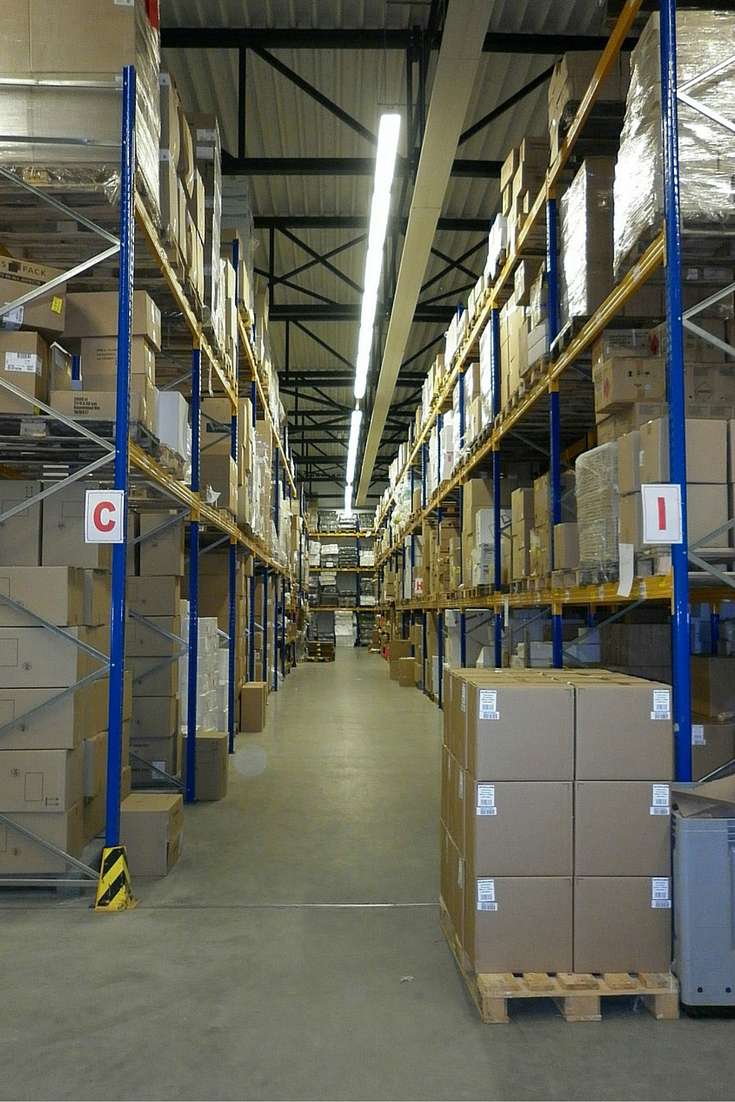
Stocking aircraft parts makes you feel comfortable. It’s your safety net. Nowadays you have plenty of outsourcing options so don’t get caught up in this myth of overstocking. Being married to your parts is a thing of the past.
You’ll spend 20% of the direct costs on every asset you own every year in holding costs.You spend $10,000 to stock a component for 2 years and you now just accumulated $4,000 in holding costs. Not to mention the capital you just tied up on the shelves.
Know your repair costs
You buy a component, great! How much is this going to cost you when it’s removed for routine, or non-routine repair?
Knowing the cost to upkeep your assets is good business. Outsourcing this is even better business.
Know your change or environmental costs
What if upper level management decides to upgrade or change your fleet?
Having a surplus of “just in case” inventory sucks capital and creates a liquidity problem. The more you have the more inflexible you become. If something in your operations strategy changes you’ll be required to liquidate your excess inventory. Know this risk and plan for it.
Know the true value your aircraft rotables create
Keeping your fleet in the air is priority number 2, first is filling your seats with passenger or your belly with cargo. Every strategy you undertake, your component support strategy must play a deciding factor. Simply buying components as needed on an AOG basis or overstocking spares is not good strategies to adopt.
Where can the most value be created for you?
All of these steps are important, but nothing is as important as a reliable supply chain. Whether you decide to outsource 95% of your aircraft maintenance activities or relay on an AOG partner, you must think long and hard about the total value they create for you. Simply bringing on more suppliers and throwing out RFQs to the world is a chaotic solution. Streamlining your focus and being diligent on the people you work with will help you resolve all of your cost problems.
Think about it. It’s difficult to envision but I assure you it makes a world of a difference.










